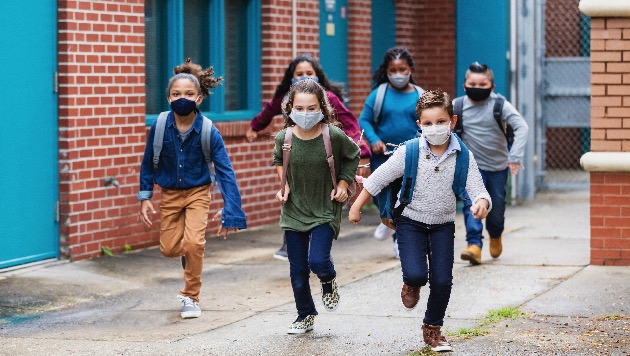How schools plan to keep students safe from COVID as cold weather arrives
kali9/iStock
(NEW YORK) — As colder temperatures begin to settle in for many parts of the nation, schools are set to lose critical tools to keep students and staff safe from coronavirus spread, such as extended outdoor time and open windows.
Despite this disadvantage, medical experts and physicians say elementary and middle school administrators can still limit the spread of the virus during the next couple of months as the vaccine rollout begins for younger age groups.
“Hopefully this year will not lead to the surge we saw last winter,” Dr. Anne Liu, clinical associate professor of medicine and pediatrics at Stanford Health, told ABC News.
Liu and other experts said the best thing schools can do is to maintain masking indoors, consistent testing, proper hand-washing practices and social distancing where applicable.
While not all schools will have up-to-date ventilation systems, masking indoors will ensure that the virus doesn’t spread among students, she said. Testing will also help keep any potential cases and outbreaks from spreading, according to medical experts.
Dr. Allison Bartlett, associate professor of pediatric infectious diseases at the University of Chicago Medicine, told ABC News that schools have already gotten into the habit of implementing these measures and, most importantly, kids have become accustomed to wearing masks.
“We now have months of experience in the real world in school settings in terms of COVID transmission and how effectively masking in schools works,” she said.
Dr. John Brownstein, an epidemiologist at Boston Children’s Hospital and an ABC News contributor, noted that mass rapid testing has also helped schools stop the spread and will be essential to keeping schools open during the winter.
“This allows kids that may have had an exposure to test and stay in school as long as they have daily negative test results,” Brownstein said.
Bartlett and other medical experts who have been studying pediatric coronavirus cases said the best tool against coronavirus spread in schools during the winter will be the approval of COVID-19 vaccines for younger students.
The U.S. Food and Drug Administration voted Tuesday to allow the Pfizer mRNA vaccine to be used for 5-to 11-year-olds. The U.S. Centers for Disease Control and Prevention are slated to vote on approving the vaccine for that age group as early as next week.
The Pfizer vaccine has been available to anyone over 12 since the spring after it was given an emergency use authorization. The FDA fully approved the Pfizer vaccine for anyone 16 and older in August.
Liu, who reviewed the data Pfizer sent to the FDA last week on 5- to 11-year-olds, said the clinical trials have shown the vaccine to be very effective at preventing severe illness, hospitalizations and deaths among that age group, so as more kids receive their doses, the safer classrooms will be in the winter.
Although it will take about five weeks for a student to be fully vaccinated from both doses, including the two-week period to build immunity after their second dose, Liu said that young students will be in a better place the minute they start their vaccination process.
“One shot alone provided strong protection based on that data,” she said.
Bartlett, who has three sons, two of whom are under 12, said that if the vaccines are approved in November, it would ensure that students have that protection preceding the holidays when they are likely to be celebrating indoors with large groups of people.
Coming back from winter break, schools will be able to mitigate any loss of outdoor space and or decreased ventilation if more of their students are vaccinated, Bartlett said. And the vaccinations could help ease class interruptions in another way, she said.
“We’ll hopefully be able to manage vaccinated children in a way that they could probably stay in school if exposed to someone with COVID and not have that disruption in their learning,” she said.
Bartlett warned that it will take a while before schools can start rolling back masking requirements because that will depend on vaccination rates among students.
“As eager as I am to get kids out of masks, I’m really in the mind to go slow,” Bartlett said. “Kids are doing an amazing job dealing with wearing masks and getting our kids able to get vaccinated will be a big motivator to get the pandemic under control.”
Bartlett added that parents must also be aware of the overall COVID-19 transmission rates within their community during the winter, because it will impact the number of cases in schools.
“I think it all could be enough, but the major contributor among kids in schools is what goes on outside the schools in the community,” she said. “If we don’t do a good job in controlling transmissions for adults it will bleed into the schools.”
Copyright © 2021, ABC Audio. All rights reserved.

